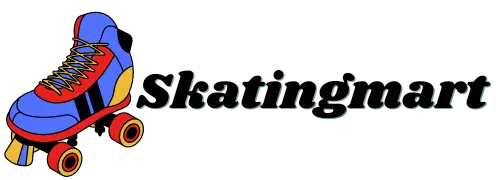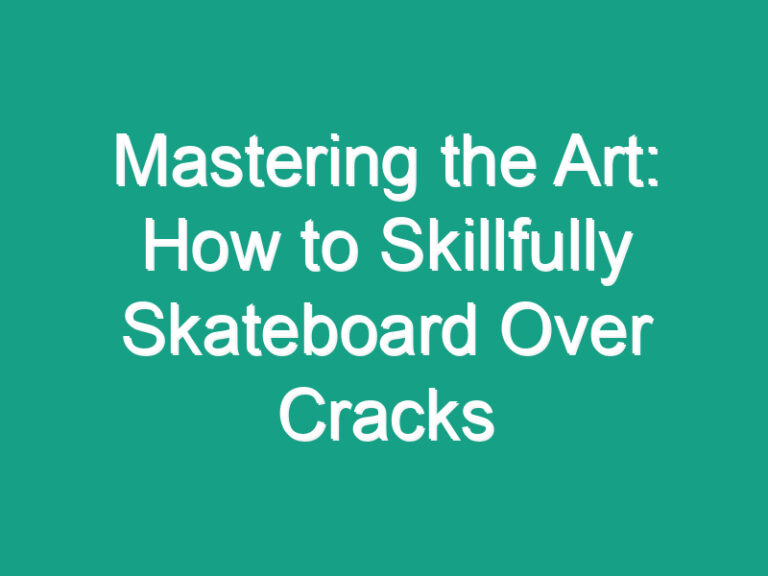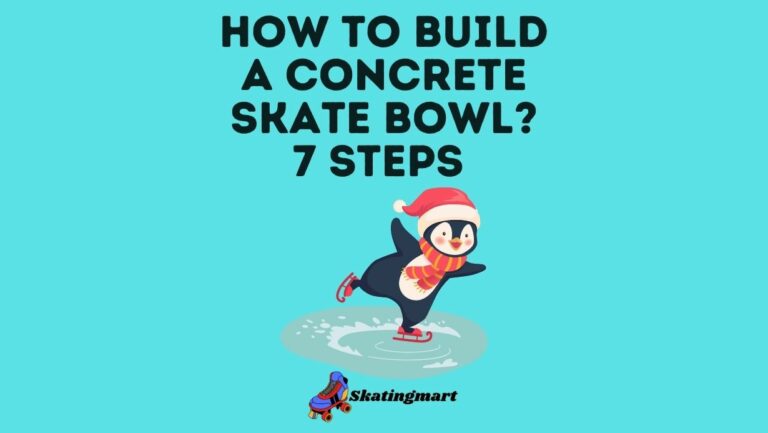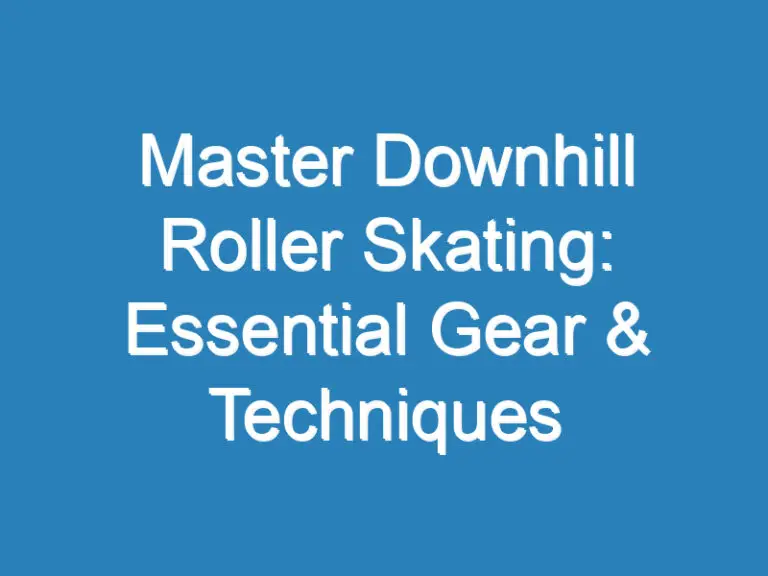
Do you struggle with pronation while skating? I’ve got you covered. Pronation can be a real pain, affecting your performance and comfort on the ice. But fear not, as I’ll share some valuable tips to help you fix pronation in your skates. Skating should be a smooth and enjoyable experience, and addressing pronation issues can make a world of difference.
As an experienced skater myself, I understand the frustration that comes with pronation problems. From proper skate fitting to specific exercises, there are various techniques that can help correct pronation and enhance your skating skills. So, lace up your skates and get ready to glide effortlessly on the ice with these practical solutions.
Key Takeaways
- Understanding pronation in skates is crucial for addressing comfort and performance issues.
- Properly addressing pronation can enhance stability, power transfer, and prevent potential injuries.
- Consult a professional for proper skate fitting to correct pronation issues effectively.
- Incorporating exercises like calf raises and ankle circles can strengthen muscles to combat pronation.
- Enhancing skating skills involves refining techniques, making skate adjustments, and consistent practice.
Understanding Pronation in Skates
When it comes to skating, pronation can significantly impact your performance and comfort on the ice. It refers to the inward rolling motion of the foot, causing the arch to collapse and the ankle to tilt inward. This can lead to various issues such as instability, uneven weight distribution, and inefficient power transfer during each stride.
Properly understanding pronation is essential for addressing any discomfort or performance issues while skating. By identifying whether you overpronate, underpronate, or have a neutral pronation, you can take the necessary steps to correct it and enhance your overall skating experience. Incorrect pronation can not only affect your performance but may also increase the risk of injuries due to the misalignment of the lower body.
Skaters experiencing pronation-related problems may notice issues such as ankle pain, blistering, or reduced stability on the ice. These symptoms indicate the need to assess your pronation and make the required adjustments to your skates and technique. Understanding how pronation impacts your skating can help you address the root cause of any discomfort or performance limitations you may be facing.
Importance of Addressing Pronation Issues
Addressing pronation issues is crucial for enhancing skating performance and comfort. Neglecting pronation problems can lead to instability, uneven weight distribution, and inefficient power transfer on the ice. When left uncorrected, these issues hinder overall skating abilities and may even increase the risk of injuries due to the misalignment caused by incorrect pronation.
By recognizing and effectively addressing pronation concerns, individuals can optimize their skating experience by improving stability, enhancing power transfer, and reducing the likelihood of pain or injury.
Unchecked pronation can result in symptoms like ankle pain and reduced stability, indicating the importance of promptly assessing and adjusting skates and techniques to rectify any pronation-related problems. Understanding how pronation affects skating fundamentally allows one to proactively address discomfort and enhance performance by focusing on the core issue.
Taking proactive steps towards addressing pronation issues not only enhances the overall skating experience but also plays a key role in preventing potential injuries due to improper alignment and weight distribution. By prioritizing the correction of pronation problems, individuals can unlock their full skating potential and enjoy a more efficient and comfortable time on the ice.
Tips for Proper Skate Fitting
When it comes to fixing pronation in skates, proper skate fitting is crucial. Here are some tips to ensure you get the right fit:
- Consult a Professional: I always recommend seeking guidance from a skate fitting expert. They can assess your pronation issues and recommend the best skates for your unique needs.
- Look for Supportive Features: Make sure the skates you choose offer adequate arch support and proper ankle stability to help correct pronation issues.
- Focus on Comfort: It’s essential to prioritize comfort when selecting skates. Discomfort or pain while skating could be a sign of improper fit, leading to pronation problems.
- Check Sizing Carefully: Proper sizing is key to addressing pronation. Ensure your skates fit snugly but don’t pinch or rub, especially around the ankle and arch areas.
- Don’t Compromise on Quality: Investing in high-quality skates can make a significant difference in correcting pronation and enhancing your skating experience.
- Regularly Evaluate Fit: As your skating skills improve, make sure to reassess the fit of your skates. Your needs may change over time, so it’s crucial to adjust accordingly.
Remember, the right fit not only fixes pronation issues but also contributes to better performance, comfort, and injury prevention on the ice.
Exercises to Correct Pronation
When it comes to addressing pronation in skates, certain exercises can help improve stability and alignment. ** Strengthening the muscles** supporting the ankles and feet is key to combating pronation issues. Here are some effective exercises that I recommend incorporating into your routine:
- Calf Raises: This exercise targets the calf muscles and helps improve ankle strength and stability.
- Ankle Circles: Rotating your ankles in circles can enhance mobility and strengthen the muscles around the ankles.
- Toe Curls: By curling your toes, you engage the muscles in your feet, promoting better support for your arches.
Consistency is vital when it comes to these exercises. I suggest incorporating them into your regular workout regimen to see noticeable improvements in pronation over time. Remember, correcting pronation is a gradual process that requires patience and persistence.
Enhancing Skating Skills
Improving skating skills involves enhancing balance, stability, and power transfer through targeted techniques and adjustments:
- Strengthening Exercises: Regularly engaging in exercises like calf raises, ankle circles, and toe curls can build the muscles supporting the ankles and feet, aiding in correcting pronation over time.
- Professional Assessment: Seeking guidance from experts for a thorough assessment of pronation issues can lead to personalized solutions for optimal performance.
- Skate Adjustments: Making necessary adjustments to skates, such as custom insoles or shims, can address pronation concerns and improve alignment and weight distribution.
- Technique Refinement: Focusing on proper form, alignment, and weight distribution while skating can help in correcting pronation and enhancing overall skating skills.
- Consistent Practice: Regularly practicing skating with an emphasis on proper techniques and alignment is crucial for reinforcing muscle memory and improving pronation issues over time.
By incorporating these strategies into my skating routine, I can work towards correcting pronation and enhancing my skills on the ice.
Conclusion
Implementing strengthening exercises, seeking professional guidance, adjusting skates, refining techniques, and consistent practice are vital steps to address pronation in skates. By following these strategies, skaters can enhance their balance, stability, and power transfer on the ice, ultimately improving their overall performance. Remember, correcting pronation takes time and dedication, but with patience and persistence, positive results can be achieved. Stay focused on your goals, trust the process, and keep pushing yourself to become the best skater you can be. Happy skating!
Frequently Asked Questions
What are some strategies to enhance skating skills mentioned in the article?
The strategies mentioned include engaging in strengthening exercises like calf raises and toe curls, seeking professional assessment for personalized solutions, making skate adjustments, refining techniques, and consistent practice.
How can I correct pronation issues to improve my skating performance?
To correct pronation over time, it is recommended to engage in strengthening exercises, seek professional assessment, make skate adjustments, refine techniques, and consistently practice to enhance balance, stability, and power transfer.
How will these strategies help me improve my performance on the ice?
Incorporating these strategies will help you correct pronation issues, enhance your overall balance, stability, and power transfer, ultimately leading to improved skating performance on the ice.

Hi, This is Roasalin, I have loved Skating since my early childhood days, and here I share my experiences and tips for beginners who want to turn into pro skaters. I hope you find it useful. you can contact me here






